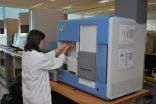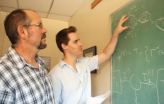(Press-News.org) Van Den Ende-Gupta syndrome (VDEGS) is an extremely rare genetic disorder that is characterized by distinctive head and facial features, such as unusual eyelids, narrow and beaked noses, flat nasal bridges, jaw deformities, and a turned out lower lip. As part of McGill's "RaDiCAL" project (Rare Disease Consortium for Autosomal Loci), collaborators in Qatar conducted field research with three patients from biologically interrelated Bedouin families, and sent samples to Canada for analysis by GA JOE – a high-tech genome analyzing machine. The research effort was led by husband and wife team Dr. Jacek Majewski and Dr. Loydie A. Jerome-Majewska, both of McGill University's Department of Human Genetics and the Research Institute of the McGill University Health Centre. The team discovered that mutations in the gene SCARF2 are responsible for the condition, and published their findings online today in the American Journal of Human Genetics.
"Why is this interesting? One of my roles at McGill is to implement new genomic technologies in human genetics research," explained Majewski. "Essentially, with a new technique known as exome capture and sequencing, we can now quickly sequence all of the coding portions of the human genome. This approach allows us to identify mutations responsible for rare genetic disorders. While they were too rare to attract much interest, these disorders hold in fact a lot of promise for the identification of the genes and pathways that are involved in generating human diversity. Moreover, knowing the mutations will be essential for future genetic testing and potential therapeutic intervention."
SCARF2 may for instance be involved in DiGeorge Syndrome, a much more common disorder affecting 1:3000 live births. DiGeorge syndrome causes deformities such as congenital heart defects. The researchers caution however that drawing links at this stage amounts to nothing more than "tantalizing speculation."
In anticipation of the fast advances in technology, McGill is identifying as many of the genes responsible for rare disorders as possible. "Over the past couple of years we've been identifying collaborators worldwide and collecting patients and DNA samples for mutation hunting," Majewski said. "This is one of the earliest successes of this project, which is still a hybrid of old and new technologies. In this particular case, although we found the mutation the old fashioned way, we had immediate confirmation using exome sequencing."
"To me the current manuscript is an early example of the enormous power of new exome/genome sequencing approaches and of the involvement of McGill researchers in this field," Majewski concluded. "It really is a harbinger of more to come."
INFORMATION:
This research received funding from the Canada Institutes for Health Research, the Research Institute of the McGill University Health Centre, and a Canada Research Chair award to Majewski. Field research was carried out by the Qatar Medical Genetic Center. Led by Dr. Tawfeg Ben-Omran, the Qatar Medical Genetic Center is staffed by expert clinical geneticists and dysmorphologists, who have developed specific areas of expertise, providing a foundation for excellent family-centred care. The sequencing was carried out in close collaboration with the staff of the Genome Quebec sequencing facility.
Bedouin tribe reveals secrets to McGill's GA-JOE
'RaDiCAL' approach to gene discovery opens doors to better understanding of human diversity and health
2010-10-01
ELSE PRESS RELEASES FROM THIS DATE:
Key leukemia defense mechanism discovered by VCU Massey Cancer Center
2010-10-01
Richmond, Va. (September 30, 2010) – Virginia Commonwealth University Massey Cancer Center researcher Steven Grant, M.D., and a team of VCU Massey researchers have uncovered the mechanism by which leukemia cells trigger a protective response when exposed to a class of cancer-killing agents known as histone deacetylase inhibitors (HDACIs). The findings, published in the Journal of Biological Chemistry, could lead to more effective treatments in patients with leukemia and other cancers of the blood.
"Our findings provide new insights into the ways such cancer cells develop ...
'Great strides' in treatment of stroke, headache, epilepsy
2010-10-01
MAYWOOD, Il. -- The latest advances in treating neurologic disorders such as stroke, headache, Parkinson's disease, epilepsy and sleep disorders are detailed in a special issue of the journal Neurologic Clinics.
Guest editor is Dr. Jose Biller, chairman of the Department of Neurology at Loyola University Chicago Stritch School of Medicine.
"Great therapeutic strides in the clinical neurosciences have been made in the past decades," Biller wrote in the preface to the November 2010 issue, now available online. "It is likely that subsequent decades will bring even greater ...
OHSU Toxicology Research Center issues public alert on popular hair salon treatment
2010-10-01
PORTLAND, Ore. — Oregon Health & Science University's Center for Research on Occupational and Environmental Toxicology (CROET) is responding to concerns raised by Portland-area hair salons about a product used for hair straightening. CROET has issued two public alerts describing its findings on the possible negative health impacts of this product.
The product being tested is called Brazilian Blowout. After receiving two samples from Portland-area salons, CROET asked the Department of Consumer and Business Services' Oregon Occupational Safety & Health Division to chemically ...
October 2010 Geology and GSA Today highlights
2010-10-01
Boulder, CO, USA – The October Geology includes a study using fish teeth to understand ocean circulation; discussion of the "Dead Clade Walking" taxa; description of the first reported example of igneous aragonite; discovery of a Paleogene California River, flowing in similar location but opposite direction to the Colorado River; a report of the earliest definite record of predation on pelagic sea lilies; and discovery of the only known active drumlin field in the world. GSA Today examines calderas.
Relationship between mass extinction and iridium across the Cretaceous-Paleogene ...
Turning waste heat into power
2010-10-01
What do a car engine, a power plant, a factory and a solar panel have in common? They all generate heat – a lot of which is wasted.
University of Arizona physicists have discovered a new way of harvesting waste heat and turning it into electrical power.
Using a theoretical model of a so-called molecular thermoelectric device, the technology holds great promise for making cars, power plants, factories and solar panels more efficient, to name a few possible applications. In addition, more efficient thermoelectric materials would make ozone-depleting chlorofluorocarbons, ...
New report on street lighting technologies available from NLPIP at Rensselaer Polytechnic Institute
2010-10-01
Troy, N.Y. – The National Lighting Product Information Program (NLPIP) released its latest Specifier Report, designed to provide objective performance information on existing street lighting technologies -- including light-emitting diode (LED), induction, and high pressure sodium (HPS) streetlights. This report comes at a critical time when many municipalities, some with funding from the American Recovery and Reinvestment Act of 2009, are in the process of replacing HPS streetlights with LED and induction models.
NLPIP, established by Rensselaer Polytechnic Institute's ...
Newly discovered planet may have water on its surface
2010-10-01
A team of astronomers that includes the University of Hawaiʻi' at Manoa's Nader Haghighipour has announced the discovery of a planet that could have liquid water on its surface.
The planet, which is probably 30 percent larger than Earth, was discovered using one of the telescopes of the W. M. Keck Observatory on Mauna Kea. It orbits a relatively small star, Gliese 581, that is 20 light-years from Earth in the constellation Libra.
"By determining the orbit of this planet, we can deduce that its surface temperature is similar to that of Earth," said Haghighipour. ...
NOAA-sponsored scientists first to map offshore San Andreas Fault and associated ecosystems
2010-10-01
For the first time, scientists are using advanced technology and an innovative vessel to study, image, and map the unexplored offshore Northern San Andreas Fault from north of San Francisco to its termination at the junction of three tectonic plates off Mendocino, Calif.
The team includes scientists from NOAA's National Marine Fisheries Service, Oregon State University, the California Seafloor Mapping Program, the U.S. Geological Survey and Woods Hole Oceanographic Institution. The expedition which concludes Sunday is sponsored by NOAA's Office of Ocean Exploration and ...
Underwater robot swims free thanks to York U-designed wireless controller
2010-10-01
TORONTO, Sept. 30, 2010 – A waterproof controller designed and built by York University researchers is allowing an underwater robot to go "wireless" in a unique way.
AQUA, an amphibious, otter-like robot, is small and nimble, with flippers rather than propellers, designed for intricate data collection from shipwrecks and reefs.
The robot, a joint project of York, McGill and Dalhousie universities, can now be controlled wirelessly using a waterproof tablet built at York. While underwater, divers can program the tablet to display tags onscreen, similar to barcodes read ...
Story tips from the US Department of Energy's Oak Ridge National Laboratory October 2010
2010-10-01
NANO -- World's smallest antenna . . .
Instead of the conventional long piece of metal or dipole antenna, electronic devices of tomorrow could incorporate an antenna no bigger than a gnat. This is made possible by a design that allows an electrically charged nano-mechanical oscillator to be tuned to specific electromagnetic waves. "Gone will be the days when we need to match the antenna length to the wavelength," said Panos Datskos, a co-developer of this proprietary technology. The potentially revolutionary system detects very small electric fields over large frequency ...
LAST 30 PRESS RELEASES:
New prostate cancer trial seeks to reduce toxicity without sacrificing efficacy
Geometry shapes life
A CRISPR screen reveals many previously unrecognized genes required for brain development and a new neurodevelopmental disorder
Hot flush treatment has anti-breast cancer activity, study finds
Securing AI systems against growing cybersecurity threats
Longest observation of an active solar region
Why nail-biting, procrastination and other self-sabotaging behaviors are rooted in survival instincts
Regional variations in mechanical properties of porcine leptomeninges
Artificial empathy in therapy and healthcare: advancements in interpersonal interaction technologies
Why some brains switch gears more efficiently than others
UVA’s Jundong Li wins ICDM’S 2025 Tao Li Award for data mining, machine learning
UVA’s low-power, high-performance computer power player Mircea Stan earns National Academy of Inventors fellowship
Not playing by the rules: USU researcher explores filamentous algae dynamics in rivers
Do our body clocks influence our risk of dementia?
Anthropologists offer new evidence of bipedalism in long-debated fossil discovery
Safer receipt paper from wood
Dosage-sensitive genes suggest no whole-genome duplications in ancestral angiosperm
First ancient human herpesvirus genomes document their deep history with humans
Why Some Bacteria Survive Antibiotics and How to Stop Them - New study reveals that bacteria can survive antibiotic treatment through two fundamentally different “shutdown modes”
UCLA study links scar healing to dangerous placenta condition
CHANGE-seq-BE finds off-target changes in the genome from base editors
The Journal of Nuclear Medicine Ahead-of-Print Tip Sheet: January 2, 2026
Delayed or absent first dose of measles, mumps, and rubella vaccination
Trends in US preterm birth rates by household income and race and ethnicity
Study identifies potential biomarker linked to progression and brain inflammation in multiple sclerosis
Many mothers in Norway do not show up for postnatal check-ups
Researchers want to find out why quick clay is so unstable
Superradiant spins show teamwork at the quantum scale
Cleveland Clinic Research links tumor bacteria to immunotherapy resistance in head and neck cancer
First Editorial of 2026: Resisting AI slop
[Press-News.org] Bedouin tribe reveals secrets to McGill's GA-JOE'RaDiCAL' approach to gene discovery opens doors to better understanding of human diversity and health

